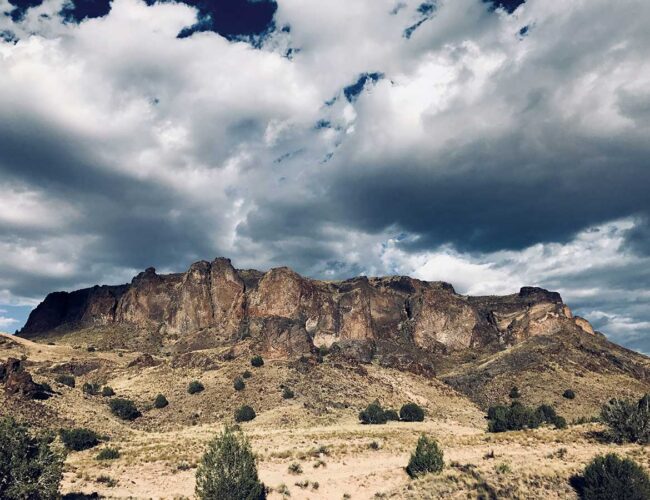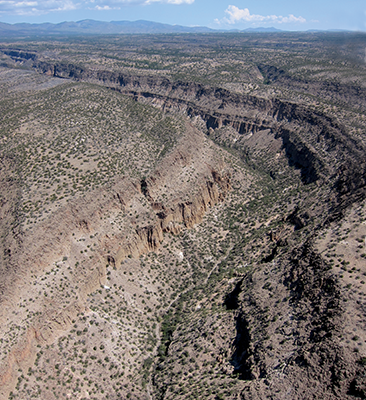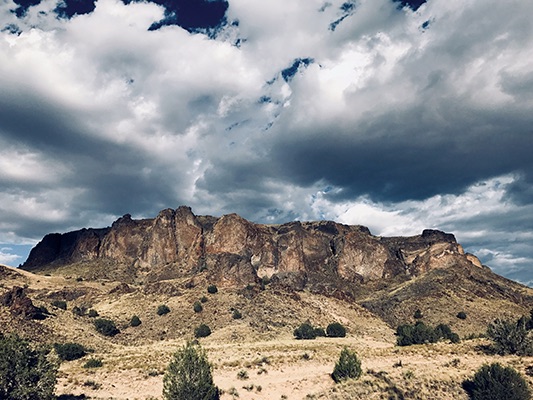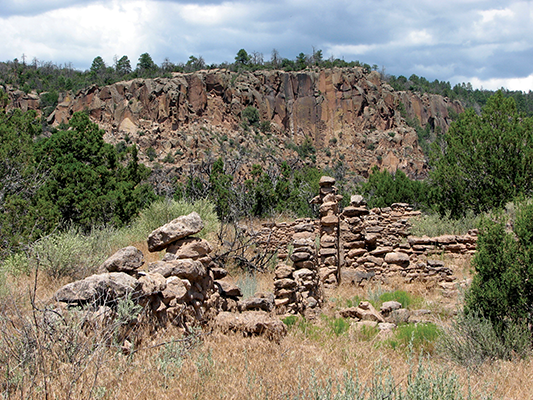The Continuous Path
Pueblo Movement and Archaeology along the Northern Rio Grande
BY ROBERT PREUCEL AND SAMUEL DUWE
When Juan de Oñate journeyed north up the Rio Grande valley in the summer of 1598, he found, to his dismay, nobody at home. As the spearhead of a colonial expedition into the heart of the Pueblo province, Oñate had hoped to march into each village, secure its allegiance to the Crown and Christ, and gain valuable allies and material support for his newfound kingdom. Instead, as he passed though the Piro and many of the Tiwa-speaking Pueblos between Socorro and Albuquerque, he encountered villages that had all of the trappings of vibrant, thriving communities, but not a soul could be found amongst the courtyards or adobe houses, and the food stores were stripped bare. Where had the people gone?
The Pueblo people had been deeply scarred by Coronado’s expedition some half-century prior, and the blood and destruction of these early skirmishes with the Spaniards were seared in Pueblo social memory. As word traveled up the Rio Grande that yet another band of horsed and armored Spaniards were moving north, many Piro and Tiwa-speaking villagers decided to evade the invaders’ steel by simply leaving their homes. They packed their precious maize and belongings and joined their friends and families at other, more remote villages. For these Pueblo people, residential mobility was a form of resistance, and a strategy for survival.
Archaeologists and anthropologists increasingly acknowledge that this fluidity of movement wasn’t a newfound strategy; it was instead part of an established tradition with deep roots in Pueblo culture. Historically the Pueblo people moved frequently to visit relatives, to participate in ceremonial practices, to engage in trade, and to conduct raids. Extensive social networks that allowed Pueblo people to join distant friends and relatives facilitated their mobility. Because of a continuous ebb and flow of people, communities continuously reformed. In fact, this pattern of fluidity was so pronounced that anthropologist Robin Fox once characterized the Pueblo people as “urbanized nomads.” By this, he meant that even though they have been practicing a village-based agricultural lifestyle for well over a millennium, they have constantly been on the move.
The Puebloans’ residential flexibility frustrated and bewildered the Spanish. They had assumed that the Puebloans, like the Europeans (and later, Americans), valued residential stasis; that their normal state of affairs was to settle down to make a home in a fixed placed for a long period of time. From the Spanish perspective, people only moved when they had to, often for dramatic reasons (drought, conflict, or the search for a better life). In fact, many archaeologists studying Pueblo history have also made this same assumption, and regarded instances of movement, such as the thirteenth-century migration of people from the Colorado Plateau to the northern Rio Grande valley, as an anomalous disruption of normal village life. Previously, archaeologists regarded these moves as adaptive responses to environmental and social stress, and they saw abandoned villages as parts of failed cultural systems. Archaeologist Severin Fowles has recently proposed that we begin to flip this idea on its head, to view Pueblo history as Pueblo people do, with the understanding that movement, rather than stasis, is the desired and normal way of life. Movement was the rule rather than the exception, and settling down in village life was simply a pause—a break—along a continuous path.
As two Anglo-American archaeologists committed to collaborative and indigenous archaeologies, we are intrigued by how Pueblo Indian perspectives can inform our research about the nature and significance of Pueblo mobility. How might Puebloan perspectives help us to rethink our historical views about movement and social being and becoming? How can we begin to write a Pueblo history that incorporates two often diverging viewpoints? Both of us have greatly benefited from our ongoing relationships with Pueblo Indian scholars and elders, and this essay is an attempt to share some of what we have learned.
The Tewa people, for example, regard all life as movement along a path or road, poeh in their language. Alfonso Ortiz, a noted anthropologist from Ohkay Owingeh Pueblo who taught at the University of New Mexico, wrote that at the beginning of life there is a single path for all people. At the initiation ceremony, the child begins upon one of two parallel paths associated with the Summer and Winter peoples (two complementary and coequal groups within the village). Upon death, the two paths come together and become one in the afterlife. The central importance of this path idea is commemorated by the name of the Poeh Center at Pojoaque Pueblo, and is the reason why the museum’s first exhibit was titled Nah Poeh Meng, or The Continuous Path.
This notion of a path is also a part of a Pueblo moral universe. It implies purposeful, directed movement and, at the same time, acknowledges the possibility of straying or getting lost and then re-finding one’s way. The late Esther Martinez, an elder at Ohkay Owingeh famous for her work on the teaching of language (recognized by the Esther Martinez Native American Language Preservation Act of 2006), described the core of her community life as sharing knowledge with the younger generation. She wrote, “People still come to my house wanting help with information for their college paper or wanting a storyteller. Young folks from the village, who were once my students in bilingual classes, will stop by for advice in traditional values or wanting me to give Indian names to their kids or grandkids. . . . This is my poeh [path]. I am still traveling.”
A number of Pueblo Indian scholars have shared their views on the role of mobility in Pueblo society. Tessie Naranjo, from Santa Clara Pueblo, states that movement is one of the “big ideological concepts” of Pueblo thought, because it is necessary for the perpetuation of life. She links the movement of people to the movement of clouds, wind, and rain, and regards them as one. Rina Swentzell, Tessie’s sister, elaborates on these ideas. She observes that ancestral Pueblo people did not settle in one place for a long time. They emulated the movement of the seasons, wind, clouds, and life cycles by moving frequently in response to floods, droughts, and social tensions. She writes, “the movement of the clouds told them how they should move on the ground,” and “their sense of home was in the space between the earth and sky and not within specific human constructions.” In this cosmology, when summer clouds build up in the afternoon and bring rain, they are bringing blessings from the ancestors. These blessings circulate through the village and back to the sacred mountains in the cardinal directions, and are honored by the dances that take place on a regular schedule in each Pueblo’s plaza.
Pueblo philosophy leads to the conclusion that the fluidity of movement in many scales and forms must serve as the foundation for all of Pueblo history. This has led us to reconsider the primacy of movement in understanding Pueblo history through two dramatic events: the formation of Pueblo worlds in the thirteenth and fourteenth centuries, and the ways in which Pueblos responded to Spanish colonization before and after the Pueblo Revolt. Our starting point is that Pueblo history is not only shaped by people coming together and moving apart, but also by creating unique identities and philosophies tied to moving through social and natural landscapes. And conversely, these philosophies mold the actions of Pueblo people throughout their dynamic histories and up to the present day.
Seeking The Middle Place
The Pueblo people know their own history. While each village’s history is unique, they all share similar origin traditions. The people emerged into this world from a lower world through a spring or lake in the north. They were then tasked with traveling south to find the middle place where they were to build their eventual homes. Along the way, the Pueblo people underwent a series of trials and adventures, and stopped multiple times on their journey. The ancient sites where they rested are often described as footprints. Once arriving at the middle place, the people, often of different backgrounds, established villages with their own unique identities. Some of these villages, such as Taos Pueblo, have been continuously occupied for over 700 years; others were only occupied for a single generation. The idea of movement, in this case migration and the coming together of different people, is therefore the crucial concept in Pueblo history. Movement shaped the history of the Pueblos.
Archaeologists, however, have only recently begun to accept that movement was and is much more the rule than the exception. While the timing, scale, and impact continue to be debated, many archaeologists working in the northern Rio Grande region now believe that migrations of people from the north, described in the Pueblo origin traditions, in some way contributed to the formation of villages and landscapes lived in and recognized by the Pueblo people today. One such migration was from southern Colorado and the Mesa Verde area in the thirteenth century. These people left their homes and joined their distant kin in the face of the disastrous environmental and social impacts of the Great Drought, which caused their crops to wither and die. But the Rio Grande region was already occupied by people who had lived there for hundreds, if not thousands, of years. The negotiations and eventual joining together of these migrant and indigenous Pueblo people catalyzed the creation of new cultural traditions that closely resemble those of the modern Pueblo people.
Acknowledging migration is only part of the story. Archaeologists are left with a number of questions, including: who were these people who came together and how did they negotiate their perhaps disparate social and ceremonial beliefs to create new societies? Sam’s research explores the history of the Tewa Pueblos, comprising six villages between Santa Fe and Española. In the Tewa origin tradition from Ohkay Owingeh the people emerged into this world through a lake in southern Colorado and were subsequently split into two groups, the Summer people and the Winter people, who were both were instructed to travel south to find the middle place. The Summer people traveled along the west side of the Rio Grande and the Winter people along the east at the flanks of the Sangre de Cristo Mountains. After twelve stops (where they built villages and lived for a short while) the people came together in the Rio Chama valley and built the village of Posi’owingeh. It was there that they created something new—one village inhabited by two people who alternated leadership seasonally—that distinguishes the Tewa from other Pueblos. The Tewa lived at Posi for a long time, but eventually left and established the other Tewa villages along the Rio Grande and its tributaries.
The archaeological evidence for the settlement of the northern Rio Grande region appears to support the Tewa oral history of multiple groups of Pueblo people coming together to create new worlds in northern New Mexico. Archaeologist Scott Ortman proposes that thousands of migrants from the Mesa Verde region settled on the Pajarito Plateau (the landform now occupied by Bandelier National Monument) in the thirteenth century. Meanwhile, on the east side of the Rio Grande north of Santa Fe there is evidence of centuries of indigenous settlement. Perhaps these two distantly related groups of people are the basis for the Summer and Winter people, respectively, in the Tewa origin tradition.
According to the tradition from Ohkay Owingeh, the two people came together in the Rio Chama basin to eventually build the village of Posi’owingeh where they created a new Tewa society. Sam’s research shows that the Chama area was uninhabited until the thirteenth century, when it began to be settled by both migrant (Summer) and local (Winter) people. For approximately a half-century, these various people living in small villages must have negotiated their identities and beliefs. However, by the mid-fourteenth century, everyone had come together and began to build very large towns along the Chama and its tributaries. One such place was Posi’owingeh. Architectural analysis reveals that the site has two very large kivas (ceremonial structures), likely one for each group of people as they came together to establish a unified village. And the location of the village itself marks an important event in Tewa history. The site overlooks the Ojo Caliente hot springs, a local representation of the place of emergence. The people lived at Posi’owingeh and other villages for two centuries until they left the Chama and joined their relatives along the Rio Grande. But their descendants have never forgotten these places, and have, over the past four centuries, reengaged their history through visiting and caring for the land, and memorializing their past in story and song. For the Tewa these migrations shaped their cultural views and also allowed them to adapt to a changing environment and thrive in their middle places in northern New Mexico.
After the Revolt of 1680
The Pueblo world that was constructed and continually renegotiated through migration and the coalescence of disparate peoples was again transformed with the arrival of the Spaniards in 1598. The Spaniards introduced the mission system and the feudal practices of taxation (encomienda) and forced labor (repartimento). These practices restricted movement and created severe hardships for Pueblo families during a time when the crops were failing due to drought. In 1680, Pueblo people rose up in a coordinated attempt to overthrow Spanish rule. What followed was the perhaps the greatest reorganization of Pueblo people since the thirteenth-century migrations. Bob’s research has examined the social effects of this reorganization. His research, and that of his colleagues Matt Liebmann and Woody Aguilar, have identified a new kind of site, the mesa village, which served as a way station for people leaving their mission villages and moving to mountain camps.
When Diego de Vargas returned in his Spanish re-conquest of New Mexico of 1692, he found large groups of peoples had moved to villages on mesa tops for refuge in an unstable social situation. These groups almost never comprised an entire village, but rather consisted of some subset of individuals, likely extended families and clans. In some cases, disputes broke out within these communities, and people left to find new mesa homes. A good example of this is the San Felipe people, who quarreled with the Cochiti people and left the village of Kotyiti to establish their own mesa village, Old San Felipe. The San Felipe people later joined with Zia and Santa Ana peoples in allying with the Spaniards, and even assisted Vargas’ attack on Kotyiti. This period reveals a wholesale social reorganization, with political identity transcending village identity. The Pueblo people relied on their ancient philosophy of movement to navigate a changing social and physical landscape.
During this period, Po’pay and other Pueblo leaders initiated a cultural revitalization movement. According to some historical accounts, “the father of all the Indians, their great captain, who had been such since the world had been inundated” instructed Po’pay to tell the people to revolt, and if they would do so, “they would live as in ancient times, regaled like the religious and Spaniards, and would gather a great many provisions and everything they needed.” Here we see references to the biblical flood story, along with a god-the-father deity. Other references state that he had “the mandate of an Indian who lives a very long way from this kingdom, toward the north, from which region Montezuma came, and who is the lieutenant of Po he yemu; and that this person ordered all the Indians to take part in the treason and rebellion.” Poseyemu, Sun Youth, is a popular culture hero known to almost all the Pueblos.
The form and layout of many of the mesa villages exhibit standardization, implying a shared ideology. Four of the mesa villages, Kotyiti, Patokawa, Boletsakwa, and Cerro Colorado, share a common architectural plan. Bob has proposed that this village form is associated with the emergence of the cultural revitalization movement. The architecture can be seen as a cosmogram of sacred places and the homes of important deities of the Keresan and Towa Pueblos’ pantheon. At Kotyiti, the gateways between the houses likely referred to specific mythological places. For example, the gateway between the two northern roomblocks may have referenced the gate of Shipap, the place of emergence located to the north. In this way, village architecture would have participated in the popular Revolt-period ideology of living in accordance with the laws of the ancestors. Peoples would have reenacted their history as they moved through the gateways into the village.
Pueblo people laid the foundations of the modern Pueblo world during the thirteenth through sixteenth centuries, when they congregated in their villages along the Rio Grande. However, becoming Pueblo is an ongoing process, and the events of the historic period are critical in understanding the identities, organization, and lifeways of the Pueblos today. The movements that followed the Pueblo Revolts of 1680 and 1696 set the social character for the modern villages. Pueblo people are likely to have relatives in many different villages. Movement enabled the Pueblos to be flexible in the face of dramatic environmental, social, and historical changes.
Always Becoming
Most people engage with the Pueblo past by visiting ancient villages and ponder what life would have been like centuries ago. We can imagine smoke rising from kivas, turkeys and children running through plazas, women crafting beautiful pottery, and families working the fields. The village is a vibrant and central place—the literal middle of the world—where people come together, regardless of their individual journeys, to strive for balance and harmony. But when we begin to think about the fluid nature of Pueblo life, we can start to imagine how these places were transitory, and always in a state of becoming. The village is simply a stop on a long and ongoing journey, where people with diverse histories look forward to an unknown, but hopeful, future.
As archaeologists, we are starting to take the long view of Pueblo history to understand the Pueblo past as a historical process that is ever changing, but one that shows striking continuity and persistence through the centuries. We are collaborating with our Pueblo colleagues to better appreciate the multiple dimensions in which they conceptualize movement. And this processes of movement is never complete, for today Pueblo people move frequently between their villages to socialize, for feast days, marriages, and baseball games. They also attend universities, serve in the military, and work in major cities. In short, the same concepts of movement that guided the actions of Pueblo people in the past continue into the present, and will do so into the future.
Robert Preucel is the director of the Haffenreffer Museum of Anthropology and a professor in the Department of Anthropology at Brown University. Samuel Duwe is an assistant professor in the Department of Anthropology at the University of Oklahoma.





